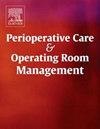Intraoperative warming during abdominal surgery with a closed-circuit water sleeve
IF 1
Q2 Nursing
Perioperative Care and Operating Room Management
Pub Date : 2025-08-16
DOI:10.1016/j.pcorm.2025.100544
引用次数: 0
Abstract
Introduction
Post-operative hypothermia is an adverse effect of anesthesia due to widespread inhibition of thermoregulatory processes, which can be mitigated through intraoperative warming. While forced warm-air systems are commonly used, they can pose challenges during procedures. Our study compared an enclosed water-sleeve warming system with a standard forced-air warming system, to compare their efficacy in maintaining normothermia during intrabdominal surgery.
Methods
In this controlled trial, 67 patients that underwent elective intrabdominal surgery were assigned to either the water-sleeve warming system (N = 30) or the forced-air warming system (N = 37). Patients gave written consent to the assignment of the warming method (IRB#1814, USF). The water-sleeve system utilized a plastic sleeve circulating warm sterile water at 40 °C on the patient's upper arm, with mild suction (-7 cm H2O) applied to promote venous dilation. The forced-air system used a disposable perforated blanket over the patient's upper body. Operating room temperatures were maintained at 20 °C. Temperatures were recorded preoperatively (sublingual), intraoperatively every 15 min (esophageal), and postoperatively upon arrival in PACU (sublingual).
Results
The water-sleeve group maintained a slightly higher median temperature intraoperatively compared to the control group, although the differences were not statistically significant. A Fisher test revealed that the water-sleeve group had fewer patients experiencing at least one intraoperative interval below 36 °C. Both warming methods successfully maintained normothermia upon arrival to the post-anesthesia care unit (PACU).
Conclusions
This study demonstrated that the water-sleeve warming system and the forced-air warming system were comparably effective in maintaining normothermia during intrabdominal surgery. No significant differences were observed in intraoperative or postoperative temperatures between the two groups. Given the similar efficacy and utility of the water-sleeve and forced-air warming systems, further research is needed to evaluate the cost-effectiveness of the water-sleeve warming system and to identify clinical scenarios where it may be preferable.
腹部手术中使用闭路水套进行术中保温
术后低体温是麻醉的不良反应,由于体温调节过程的广泛抑制,可以通过术中加热来减轻。虽然通常使用强制暖空气系统,但它们在操作过程中可能会带来挑战。我们的研究比较了封闭的水套加热系统和标准的强制空气加热系统,比较了它们在腹腔手术期间维持体温正常的效果。方法在本对照试验中,67例择期腹腔手术患者被分配到水套加热系统(N = 30)和强制空气加热系统(N = 37)。患者书面同意使用升温方法(IRB#1814, USF)。水套系统利用塑料套循环40°C的温无菌水在患者上臂上,轻微吸引(-7 cm H2O)以促进静脉扩张。强制空气系统使用一次性穿孔毯盖在病人的上半身。手术室温度保持在20℃。术前(舌下)、术中(食管)每15分钟记录一次体温,术后到达PACU时(舌下)记录一次体温。结果水套组术中中位温度略高于对照组,但差异无统计学意义。Fisher试验显示,水套组至少有一次术中间隔低于36°C的患者较少。两种加热方法在到达麻醉后护理单元(PACU)时都成功地维持了正常体温。结论水套加热系统与强制空气加热系统在腹腔手术中维持体温的效果相当。两组患者术中或术后温度均无显著差异。鉴于水套加热系统和强制空气加热系统的功效和效用相似,需要进一步的研究来评估水套加热系统的成本效益,并确定它可能更可取的临床场景。
本文章由计算机程序翻译,如有差异,请以英文原文为准。
求助全文
约1分钟内获得全文
求助全文
来源期刊

Perioperative Care and Operating Room Management
Nursing-Medical and Surgical Nursing
CiteScore
1.30
自引率
0.00%
发文量
52
审稿时长
56 days
期刊介绍:
The objective of this new online journal is to serve as a multidisciplinary, peer-reviewed source of information related to the administrative, economic, operational, safety, and quality aspects of the ambulatory and in-patient operating room and interventional procedural processes. The journal will provide high-quality information and research findings on operational and system-based approaches to ensure safe, coordinated, and high-value periprocedural care. With the current focus on value in health care it is essential that there is a venue for researchers to publish articles on quality improvement process initiatives, process flow modeling, information management, efficient design, cost improvement, use of novel technologies, and management.
 求助内容:
求助内容: 应助结果提醒方式:
应助结果提醒方式:


